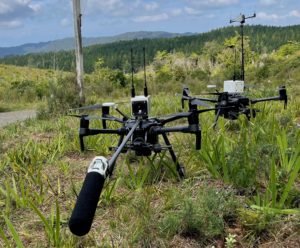A two way radio for drones from Dotterel Technologies means that drone operators could actually have a two-way conversation with people on the ground.
The sophisticated audio payload allows for communications despite the sound of the drone itself. The applications for a two way radio for drones are tremendous, but Dotterel has started out with one of the most compelling: search and rescue.
Drones have become a critical tool for search and rescue operations, because they can cover a large area quickly. Operators seek missing persons through cell phone signals, thermal imaging, and visual imaging, but until now they haven’t been able to locate a missing person by one of the most obvious methods: a cry for help.
Shaun Edlin, CEO of Dotterel, and his team demonstrated the application to a multi-agency search and rescue exercise in the Hunua Ranges, Auckland, New Zealand. “Dotterel has found a way to put its unique, highly directional microphone array and processor on drones so that it can capture audio while rejecting drone propellor noise and other loud environmental noise,” explains a company press release.
“The audio system is two way so that the rescuers can not only hear the missing people call for help but also ask questions about injuries, other people and their location and advise of rescue actions,” Edlin says.
“Drones are used frequently in public safety situations around the world, like search and rescue and for improving situational awareness. We are being approached by many public safety groups globally as word spreads about our unique audio capability. Of particular interest is using drones as remote communication tools in Search and Rescue, and to help deescalate situations in long range negotiations while keeping operational teams safe.”
Auckland search and rescue (SAR) leader Brandon McCarthy says the audio addition to drones will make them an even more valuable tool in the SAR kit.
“It wasn’t hard to see from Dotterel’s demonstration that the audio capability could be used to quickly gather critical information from missing people, or to pick up their voices when it flies across locations. This is important, as many missing people are found by rescuers listening for voice appeal in hard-to-reach locations and the ability to quickly extend our hearing range is of high value.”
Edlin says the Aerial Audio solution will help save lives and reduce risk for both civilians and operational public service teams: but the commercial and military applications. Whether providing instructions to groups of field personnel on industrial missions, communicating to military operatives, or working in public safety applications, two way radios for drones could prove an important new payload for many sectors in the industry.
Miriam McNabb is the Editor-in-Chief of DRONELIFE and CEO of JobForDrones, a professional drone services marketplace, and a fascinated observer of the emerging drone industry and the regulatory environment for drones. Miriam has penned over 3,000 articles focused on the commercial drone space and is an international speaker and recognized figure in the industry. Miriam has a degree from the University of Chicago and over 20 years of experience in high tech sales and marketing for new technologies.
For drone industry consulting or writing, Email Miriam.
TWITTER:@spaldingbarker
Subscribe to DroneLife here.








Thank you for your posts. I find them very informative.